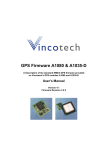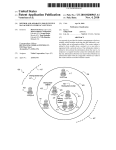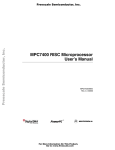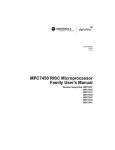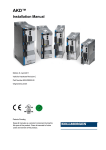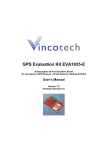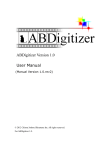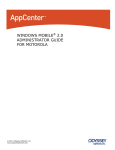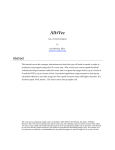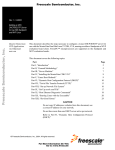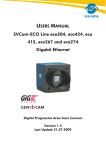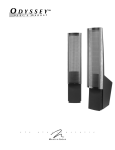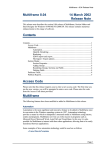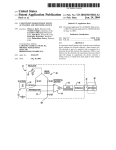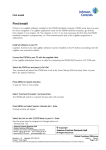Download Matrox Odyssey Developers` Toolkit
Transcript
Matrox
Odyssey Developer’s Toolkit
Development toolkit for native programming of the Motorola®
G4 PowerPC™ microprocessor and Matrox Pixel Accelerator.
Harness the full power of the Matrox Odyssey
family of vision processor boards
The Matrox Odyssey Developer's Toolkit (DTK) complements the Matrox
Odyssey Software Development Toolkit (SDK) by providing additional
programming levels. These levels allow developers to fully extract the power of
the Matrox Odyssey family of vision processor boards. Developers can increase
system determinism by running Matrox Imaging Library (MIL) and/or Matrox
Odyssey Native Library (ONL) control code directly on the Motorola® G4
PowerPC™ microprocessor, further optimize an algorithm by merging ONL
functions, and extend a MIL or ONL-based application with custom image
processing and analysis functions implemented directly on the G4 or Matrox
Oasis ASIC's Pixel Accelerator (PA).
Includes
Matrox Odyssey Software Development Toolkit
- Matrox Imaging Library (MIL) for Odyssey1
- Matrox Odyssey Native Library (ONL)
Matrox Odyssey Developer's Guide manual
MIL for Odyssey and ONL in object code form
(not linked)
programming examples
Matrox compiler and linker utilities
advanced technical support
Requires
Matrox Odyssey family vision processor board
Metrowerks® CodeWarrior for PowerPC™ Embedded
Systems and Motorola® documentation2
Preliminary
Increase system determinism
With the DTK, developers can easily move the control portion of an
application from the host to the G4 to offload this time-critical task. As a
result, real-time operations are guaranteed, even when the host CPU is
running a non real-time OS and is busy with other system tasks (i.e., HMI,
disk, network, I/O). Porting all or just a portion of the application from the
host to the G4 requires no specialized knowledge of the G4. DTK users still
have access to all MIL and ONL functions, and programming is performed in
standard C/C++.
Optimize an ONL-based algorithm
DTK users can merge a sequence of ONL functions into a single new function
to speed-up execution by reducing I/O with on-board main memory.
Merged functions can run several times faster than the original sequence of
ONL functions since intermediate results are stored in the G4's cache rather
than in main memory. This kind of optimization is easy to implement since
the DTK provides a large set of optimized low-level processing primitives
that can be combined together to build more complex functions without
writing any custom AltiVec™ code.
Using the DTK's low-level processing primitives
Consider an algorithm, which adds three 8-bit buffers (call them A, B, and C),
then binarizes the result to an 8-bit value. The first implementation
(shown below) uses standard ONL calls and a 16-bit temporary buffer to
hold the intermediate results. The 16-bit temporary buffer is read twice
and written twice, so the total number of memory accesses is 12
bytes/pixel instead of the ideal 4 bytes/pixel.
imIntDyadic(Thread, SrcA, SrcB, TmpBuf, IM_ADD, 0);
imIntDyadic(Thread, SrcC, TmpBuf, TmpBuf, IM_ADD, 0);
imIntBinarize(Thread, TmpBuf, Dst, IM_GREATER, Thresh, 0, 255, 0, 0);
The optimized version avoids all the unnecessary I/O by processing the
image block-by-block using low-level processing primitives. It will
execute almost three times faster than the first version, and doesn't
require any custom AltiVec™ code. The main loop is written as follows.
for (Block = 0; Block < NumBlock; Block++)
{
/* Read the first two sources and convert to 16-bit */
NumPix = NextSrcA(&BlockSrcA, TmpBuf1);
NextSrcB(&BlockSrcB, TmpBuf2);
Write custom functions
While MIL and ONL offer an extensive list of functions, there are some cases
where a developer will need to write custom G4 and/or PA code to perform a
specialized operation. For this purpose, the DTK allows for programming of
the G4's AltiVec™ unit and PA's processing elements directly.
Programming the G4 is done exclusively in C/C++ using language
extensions and intrinsic functions. The DTK provides the framework to
facilitate the writing of custom functions and dramatically reduces
software development time. For example, when programming for the G4
directly, DTK users only need to write a simple inner loop to process whole
aligned vectors. Variable image sizes, unaligned images, and mixed data
types are all automatically supported. Moreover, memory bandwidth is
maximized since pre-fetching is also handled automatically.
AltiVec™ programming
The first loop is standard C code, which adds two blocks of 8-bit pixels
together (one pixel at a time).
unsigned char *Src1, *Src2, *Dst;
…
for (X = 0; X < SizeX; X++)
Dst[X] = Src1[X] + Src2[X];
The next version uses the AltiVec™ programming model to perform
the same operation much faster, because it works on one vector
(sixteen 8-bit pixels) at a time.
vector unsigned char *vSrc1, *vSrc2, *vDst;
…
/* Get the size in vectors, not pixels */
SizeX = SizeX / vec_step(vector unsigned char);
for (X = 0; X < SizeX; X++)
vDst[X] = vec_add(vSrc1[X], vSrc2[X]);
The only differences are that the pointers are declared to be a vector type,
the loop counter is divided by 16 (because 16 pixels are processed at
once), and the addition is specified by the AltiVec™ intrinsic function
vec_add() rather than with the standard "+" operator.
/* Add the first two sources */
mp_1d_add_16(TmpBuf1, TmpBuf2, TmpBuf2, NumPix);
/* Read the third source and convert to 16-bit */
NextSrcC(&BlockSrcC, TmpBuf1);
/* Add the third source */
mp_1d_add_16(TmpBuf1, TmpBuf2, TmpBuf2, NumPix);
/* Binarize the sum */
mp_1d_bin_gt_u16(TmpBuf2, TmpBuf2, vThresh, v0, v255, v0,NumPix);
/* Convert the result back to 8-bit and store it */
NextDst(&BlockDst, TmpBuf2);
}
2
Preliminary
Write custom functions (continued)
The PA is flexible enough to execute a wide variety of operations that may
not have equivalents in MIL or ONL. The DTK makes it easy to do most of
the PA set up, leaving you to implement only the nanocode to process each
pixel. PA nanocode is rather like assembly code, but most custom
functions only use short sequences of 5 to 10 instructions, so the effort
required is minimal.
PA programming
Consider the algorithm described earlier (i.e., add three buffers and
binarize the result). The following code sets up the PA to read the three
source buffers and write the destination buffer.
/* Initialize for a point operation with three sources and one dest. */
mp_pa_set_mode(&PA, IM_OP_POINT, 3, 1, IM_SINGLE, IM_DISABLE);
Development platform
The hardware platform used to create, compile and debug custom code is
a host PC with a Matrox Odyssey family vision processor board. Code is
generated on the host PC and then downloaded to the G4 for testing and
debugging. Users will also need Metrowerks® CodeWarrior for PowerPC™
Embedded Systems. CodeWarrior consists of a compiler, linker and
debugger all working within an integrated development environment.
CodeWarrior makes embedded code development as easy as developing
applications for the PC. Moreover, with CodeWarrior, there is no need for a
hardware emulator since the debugger interacts directly with the vision
processor board over the PCI/PCI-X bus.
Comes with preferred access
DTK customers have preferential access to our experienced staff
of developers specializing in coding imaging functions for the Matrox
Odyssey architecture.
/* Program the sources */
mp_pa_set_src(&PA, 1, SrcA, 0, SizeX, SizeY, IM_DEFAULT);
mp_pa_set_src(&PA, 2, SrcB, 0, SizeX, SizeY, IM_DEFAULT);
mp_pa_set_src(&PA, 3, SrcC, 0, SizeX, SizeY, IM_DEFAULT);
/* Program the destination */
mp_pa_set_dst(&PA, 0, Dst, 0, SizeX, SizeY, IM_DEFAULT);
The most complicated thing to do is writing the nanocode to process each
pixel (see below), but in this case it consists of only four instructions.
Note that the same code will execute simultaneously on all 64 processing
elements of the PA.
; Inputs are:; R1
SrcA
; R2
SrcB
; R3
SrcC
; R4
0
; C0
Thresh
; C2
255
;
ADD(R1, R2)
ADD(R3, A1)
LOOP
SUB(C0, A1)
OUT
SEL(N, C2, R4)
; Add the first two buffers (result will be in A1)
; Add the third to get the final sum
; Thresh-Sum sets the N flag if Sum > Thresh
; Sum > Thresh ? 255 : 0
Preliminary
3
Ordering Information
Part number
Hardware
MIL ONL WIN DTK
Description
Matrox Odyssey Developer's Toolkit (DTK)
under Windows®. Includes CD with MIL for
Odyssey, ONL, MIL DTK and ONL DTK.
Users will also need to purchase Metrowerks® CodeWarrior for PowerPC™
Embedded Systems (version 6.1 or later) directly from Metrowerks®:
Software
Part number
CE-EPPCx3
Description
CodeWarrior for PowerPC™ Embedded
Systems, hosted on Windows®
Notes:
1. MIL for Odyssey includes MIL for IA32 (host PC), which requires additional
development or run-time license.
2. AltiVec™ Technology Programming Environments Manual, AltiVec™ Technology
Programming Interface Manual and MPC7450 RISC Microprocessor Family
User's Manual.
3. Where ‘x’ is version number.
Preliminary
For more information, please call: 1-800-804-6243 (toll free in North America)
or (514) 822-6020 or e-mail: [email protected] or http://www.matrox.com/imaging
Corporate headquarters:
Offices:
Canada and U.S.A.
Matrox Electronic Systems Ltd.
1055 St. Regis Blvd.
Dorval, Quebec H9P 2T4
Canada
Tel: (514) 685-2630
Fax: (514) 822-6273
Europe, Middle East & Africa
Matrox VITE Limited
Sefton Park
Stoke Poges
Buckinghamshire
SL2 4JS
U.K.
Tel: 01753 665511
Fax: 01753 665599
France
Matrox France SARL
2, rue de la Couture,
Silic 225
94528 Rungis Cedex
Tel: (0) 1 45-60-62-00
Fax: (0) 1 45-60-62-05
Germany
Matrox Electronic Systems GmbH
Inselkammerstr. 8
D-82008 Unterhaching
Germany
Tel: 089/62170-0
Fax: 089/614 9743
All trademarks by their respective owners are hereby
acknowledged. Matrox Electronic Systems, Ltd. reserves
the right to make changes in specifications at any time
and without notice. The information furnished by Matrox
Electronic Systems, Ltd. is believed to be accurate and
reliable. However, no responsibility license is granted
under any patents or patent rights of Matrox Electronic
Systems, Ltd. Windows and Microsoft are trademarks of
Microsoft Corporation. MMX and the MMX logo are
registered trademarks of Intel Corporation. Printed in
Canada, 10-10-2002. $IE-5288-D




